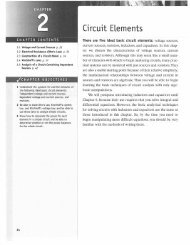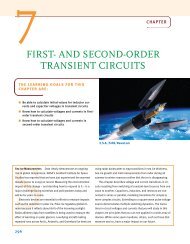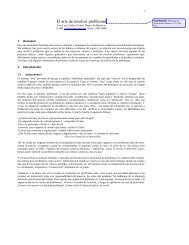You also want an ePaper? Increase the reach of your titles
YUMPU automatically turns print PDFs into web optimized ePapers that Google loves.
6 CHAPTER 1 <strong>BASIC</strong> <strong>CONCEPTS</strong><br />
EXAMPLE<br />
1.1<br />
Suppose that your car will not start. To determine whether the battery is faulty, you turn on<br />
the light switch and find that the lights are very dim, indicating a weak battery. You borrow<br />
a friend’s car and a set of jumper cables. However, how do you connect his car’s battery to<br />
yours? What do you want his battery to do?<br />
SOLUTION<br />
Figure 1.10<br />
Diagram for Example 1.1.<br />
Essentially, his car’s battery must supply energy to yours, and therefore it should be<br />
connected in the manner shown in Fig. 1.10. Note that the positive current leaves the positive<br />
terminal of the good battery (supplying energy) and enters the positive terminal of the<br />
weak battery (absorbing energy). Note that the same connections are used when charging a<br />
battery.<br />
I<br />
I<br />
+ – + –<br />
Good<br />
battery<br />
Weak<br />
battery<br />
In practical applications there are often considerations other than simply the electrical<br />
relations (e.g., safety). Such is the case with jump-starting an automobile. Automobile<br />
batteries produce explosive gases that can be ignited accidentally, causing severe physical<br />
injury. Be safe—follow the procedure described in your auto owner’s manual.<br />
We have defined voltage in joules per coulomb as the energy required to move a positive<br />
charge of 1 C through an element. If we assume that we are dealing with a differential amount<br />
of charge and energy, then<br />
v = dw<br />
dq<br />
1.2<br />
Multiplying this quantity by the current in the element yields<br />
vi = dw<br />
dq a dq<br />
dt b = dw dt<br />
= p<br />
1.3<br />
i(t)<br />
+<br />
v(t)<br />
Figure 1.11<br />
Sign convention for power.<br />
[hint]<br />
–<br />
The passive sign convention<br />
is used to determine whether<br />
power is being absorbed or<br />
supplied.<br />
which is the time rate of change of energy or power measured in joules per second, or watts<br />
(W). Since, in general, both v and i are functions of time, p is also a time-varying quantity.<br />
Therefore, the change in energy from time t 1 to time t 2 can be found by integrating Eq. (1.3);<br />
that is,<br />
t 2<br />
t 2<br />
¢w = p dt = vi dt<br />
3 t 1 3<br />
At this point, let us summarize our sign convention for power. To determine the sign of<br />
any of the quantities involved, the variables for the current and voltage should be arranged as<br />
shown in Fig. 1.11. The variable for the voltage v(t) is defined as the voltage across the element<br />
with the positive reference at the same terminal that the current variable i(t) is entering.<br />
This convention is called the passive sign convention and will be so noted in the remainder<br />
of this book. The product of v and i, with their attendant signs, will determine the magnitude<br />
and sign of the power. If the sign of the power is positive, power is being absorbed by the element;<br />
if the sign is negative, power is being supplied by the element.<br />
t 1<br />
1.4













